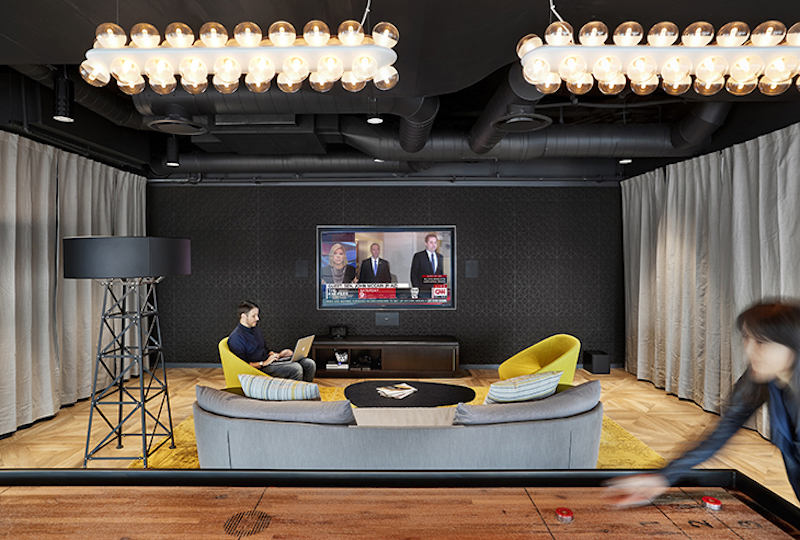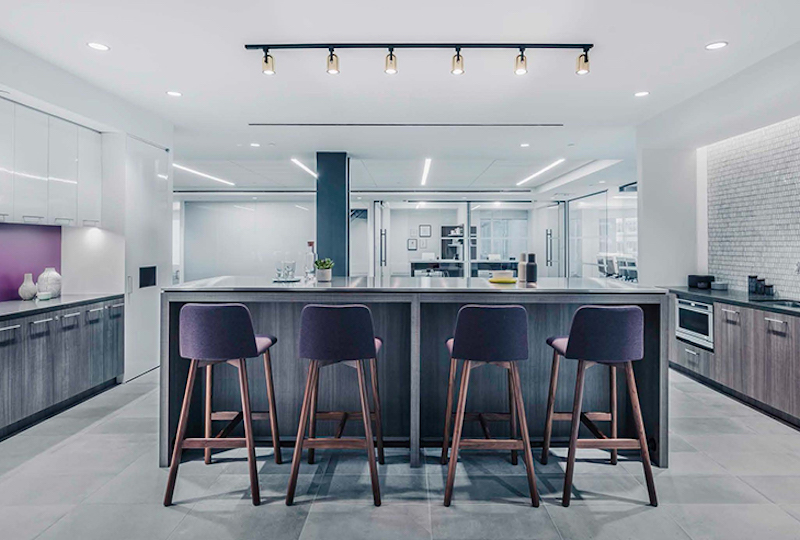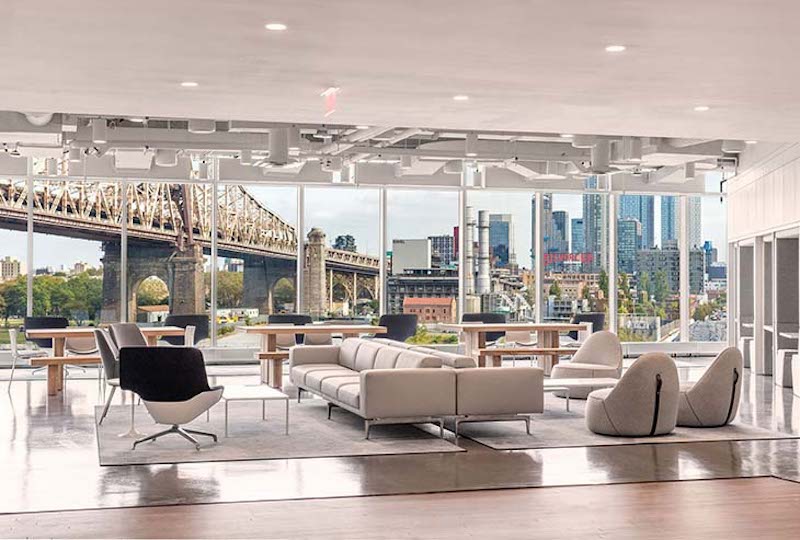Historically, New York commercial buildings have not needed to offer amenities to stand out. The city served as the office backyard, providing food, fitness, and sub-cellar bowling alley experiences. Now, buildings are full of them. The competition amongst developers and building owners to lease space is so fierce that the need to differentiate is more important than ever. Today’s employees are sophisticated consumers who are choosing where they want to work based on specific preferences. Understanding how amenities can support their growing demands is key to unlocking a building’s differentiation strategy. In the tightly competitive commercial leasing market, how can a property stand out relative to its peers and support its tenants?
Here, we offer five ways that amenities can help developers and building owners attract and secure tenants by appealing to their inhabitants:
1. Embrace the Neighborhood and Building Authenticity
The amenities that a building owner elects to implement are ultimately a manifestation of the building’s values and a direct reflection of its tenant population’s perceived brand image. Therefore, services and offerings must be tailored and in direct alignment with the culture of the building’s population. For example, a shared game room is more affiliated from a cultural perspective with a Midtown South tech-centric boutique building than a Hudson Yards high-rise intended for law firms and hedge funds.
Some new high-rise towers in Midtown are focusing on attracting global, sophisticated high-end financial or professional services firms. A hospitality service model with club-like offerings is the best approach to attracting this type of tenancy. One in particular will offer a conference suite, which will be supported by a concierge, a fine dining restaurant, full-service bar, a flexible town hall, and a business lounge.
 One World Commons, the amenity floor for tenants at One World Trade Center. Image © Garrett Rowland.
One World Commons, the amenity floor for tenants at One World Trade Center. Image © Garrett Rowland.
2. Understand Your Target Audience
Commercial real estate companies have had to adjust to competition from co-working spaces as tenants pack employees into smaller offices. While tenants benefit from amenity-rich buildings as a recruiting and retaining tool, they also benefit from being able to be more efficient with their space. For example, a tenant may be able to reduce its internal conference rooms where the building offers extensive conference facilities and fit in more employees.
In envisioning One World Commons, the amenity floor on the 64th floor of One World Trade Center, The Durst Organization wanted to create an environment that could build community for all the building’s inhabitants. It was important to design a series of spaces with programs that young media and tech tenants in the building could take advantage of, from Condé Nast to High 5 Games to Mic. The result is a grab-and-go café, a game room, a business lounge, and a multipurpose room that could be sectioned off for private events. By providing lunch and conferencing facilities, the amenity floor now serves as a programmatic supplement to future tenants looking for space in the building, affecting their own design and real estate decisions.
3. Create a Curated Ecosystem
Amenities should be designed to boost employee productivity, keep people on-site longer, and provide convenience, with the goal to maximize employee time to explore personal ideas. “Gained” time should inevitably result in some sort of value or increase for a tenant’s bottom line. “Found” time can be generated in different ways depending on the type of tenant and the industries that they are in, from idea production to dry cleaning pick-up.
At the Tata Innovation Center at Cornell Tech, a partnership between Forest City New York and Cornell University, the shared amenity space was purposefully designed to encourage mutually beneficial interactions with other tenants on the same floor and external visitors. Such spontaneous conversations would maximize idea generation and partnerships, simplify processes, and build business connections, ultimately impacting the tenants’ bottom line.
4. Align a Holistic Building POV
Design has the capacity to self-curate certain types of industries and prospective tenants. Like consumers, companies tend to be attracted to personalities and brands that most align with their own point of view. The base building is the first interaction that an employee has with their workplace environment, so this experience should be consistent, from street to seat.
Equity Office’s Park Avenue Tower sought to deliver a financial services product from top to bottom as a cohesive design story with a bespoke brand. They developed a fast and efficient turnkey program that allows for semi-customizable move-in ready suites that have the look of a customized office space. This spoke directly to the fast-paced world of hedge funds and financial services firms. The heavily amenitized building begins at the plaza, extending into a newly renovated lobby, and into the lower level, which is now known as the Hedge Fund Club. The link between all of the spaces and environments in Park Avenue Tower is a consistent attitude that enables the building to have a strong identity.
 Equity Office’s move-in ready suites at Park Avenue Tower. Image © REA.
Equity Office’s move-in ready suites at Park Avenue Tower. Image © REA.
5. Provide an “On-Site Off-Site” Mentality
Amenities also function as an escape from the typical workplace environment, providing a “third place” option for employees to slip into for social interactions or more focused work. As office environments become increasingly more dense, tenants are having to provide more choice to their employees through space type variety.
At 21 Penn, the overarching goal was to provide an “on-site off-site” for tenants to drop down to throughout the day, as an extension of their own office upstairs. The ground floor club will feature a gaming area with a fireplace, serviced by an outside operator for socializing and encouraging coworker interactions. In addition, a library with phone rooms will supplement the workplace floors, offering quiet focused space that might not exist on the actual tenant floors.
Ultimately, the best buildings put their tenants at the forefront, and the best companies invest in their talent. A successful amenity offering elevates the everyday experience by leveraging the authentic personality of its tenant population and allows them to work, think, and create better.
More from Author
Gensler | Oct 21, 2024
3 surprises impacting the return to the office
This blog series exploring Gensler's Workplace Survey shows the top three surprises uncovered in the return to the office.
Gensler | Jun 26, 2024
5 ways ESG can influence design and create opportunities
Gensler sustainability leaders Stacey Olson, Anthony Brower, and Audrey Handelman share five ways they're rethinking designing for ESG, using a science-based approach that can impact the ESG value chain.
Gensler | May 20, 2024
10 spaces that are no longer optional to create a great workplace
Amenities are no longer optional. The new role of the office is not only a place to get work done, but to provide a mix of work experiences for employees.
Gensler | Apr 15, 2024
3 ways the most innovative companies work differently
Gensler’s pre-pandemic workplace research reinforced that great workplace design drives creativity and innovation. Using six performance indicators, we're able to view workers’ perceptions of the quality of innovation, creativity, and leadership in an employee’s organization.
Gensler | Mar 13, 2024
Trends to watch shaping the future of ESG
Gensler’s Climate Action & Sustainability Services Leaders Anthony Brower, Juliette Morgan, and Kirsten Ritchie discuss trends shaping the future of environmental, social, and governance (ESG).
Gensler | Feb 15, 2024
5 things developers should know about mass timber
Gensler's Erik Barth, architect and regional design resilience leader, shares considerations for developers when looking at mass timber solutions.
Gensler | Jan 15, 2024
How to keep airports functional during construction
Gensler's aviation experts share new ideas about how to make the airport construction process better moving forward.
Gensler | Dec 18, 2023
The impacts of affordability, remote work, and personal safety on urban life
Data from Gensler's City Pulse Survey shows that although people are satisfied with their city's experience, it may not be enough.
Gensler | Nov 16, 2023
How inclusive design supports resilience and climate preparedness
Gail Napell, AIA, LEED AP BD+C, shares five tips and examples of inclusive design across a variety of building sectors.
Gensler | Oct 16, 2023
The impact of office-to-residential conversion on downtown areas
Gensler's Duanne Render looks at the incentives that could bring more office-to-residential conversions to life.
















